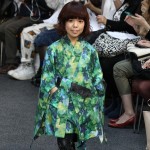Givenchy’s “Chola” Inspired Runway and Cultural Appropriation in High Fashion
When asked about this look, Riccardo Tisci, creative director at Givenchy, gave a quote to Vogue saying that the girl in his collection is, “Chola Victorian. She’s the boss of the gang.” The quote has since then become widely circulated, along with praise for Tisci’s ‘cool’ and ‘deep’ interpretation of youth culture. One thing the press has failed to mention, however, is Tisci’s problematic use of the term ‘chola’.
The word ‘chola’ has been a part of mainstream vernacular for decades, but originated in the 1800s. It was first used to describe those who identified as a mixed raced person of Latin American or Indian descent and was later used to refer to low income Mexican immigrants until it was adopted by Latino gangs in the 70s––the use that is most widely known today.
So what’s the problem? Tisci is just the latest designer to appropriate a minority culture for the sake of high fashion, and the world is letting him get away with it. According to Refinery 29 out of over 40 models that walked in Tisci’s show, Joan Smalls was the only model of Latin descent to walk. This gross under representation of the hispanic culture that Tisci is claiming is just the tip of the iceberg. Notable and highly respected industry experts are lauding this blatant misappropriation and sweeping the entire issue under the rug.
Nicole Phelps, a reviewer on Style.com, wrote, “‘Victorian-chola girl,’ is how [Tisci] described the collection, and, as usual, it was a deeply personal trip.” How can the collection be deeply personal if Tisci has never been a ‘chola girl’? And why tone down––or let’s face it, whiten––the reference with the use of ‘victorian’.
Phelps goes on to write, “As an Italian, Tisci has always had a thing for Latin archetypes. The California chola girl qualifies,” otherwise saying that being Italian somehow excuses him from appropriating a significant part of Latin culture.
This is not to say that Tisci or anyone who appropriates under represented cultures is ignorant. In fact, Tisci has a history of promoting diversity in the often two dimensional world of fashion. According to The Guardian, he was the first designer to embrace Kim Kardashian’s natural curves and has been an avid supporter of transgender model Lea T’s career.
The problem at hand is taking a minority culture and displaying it for consumption by the masses incorrectly, and without blame. How do 40 models of non-Hispanic descent represent chola culture? While I am not Latina, as someone who is a part of a minority culture I can still sympathize with, and recognize, being incorrectly and under represented by the media. I’m all for girl gangs and the positive portrayal of youth culture, but if you’re going to stake a claim to something at least do it right.




















 Designer Takafumi Tsurata Confronts Fashion’s Lack of Diversity at Tokyo Fashion Week
Designer Takafumi Tsurata Confronts Fashion’s Lack of Diversity at Tokyo Fashion Week
 Laverne Cox Bares All in Allure’s ‘Nudes’ Issue
Laverne Cox Bares All in Allure’s ‘Nudes’ Issue
 Heidi Klum’s Flawless #NoMakeup Selfie
Heidi Klum’s Flawless #NoMakeup Selfie
 Adidas Sues Marc by Marc Jacobs Over Stripes
Adidas Sues Marc by Marc Jacobs Over Stripes















